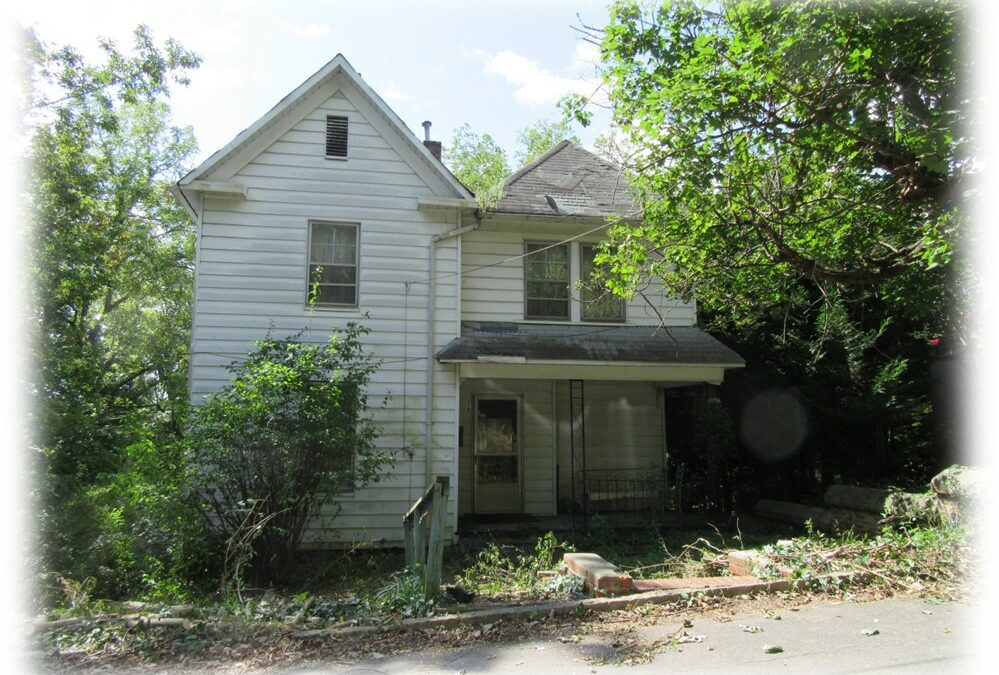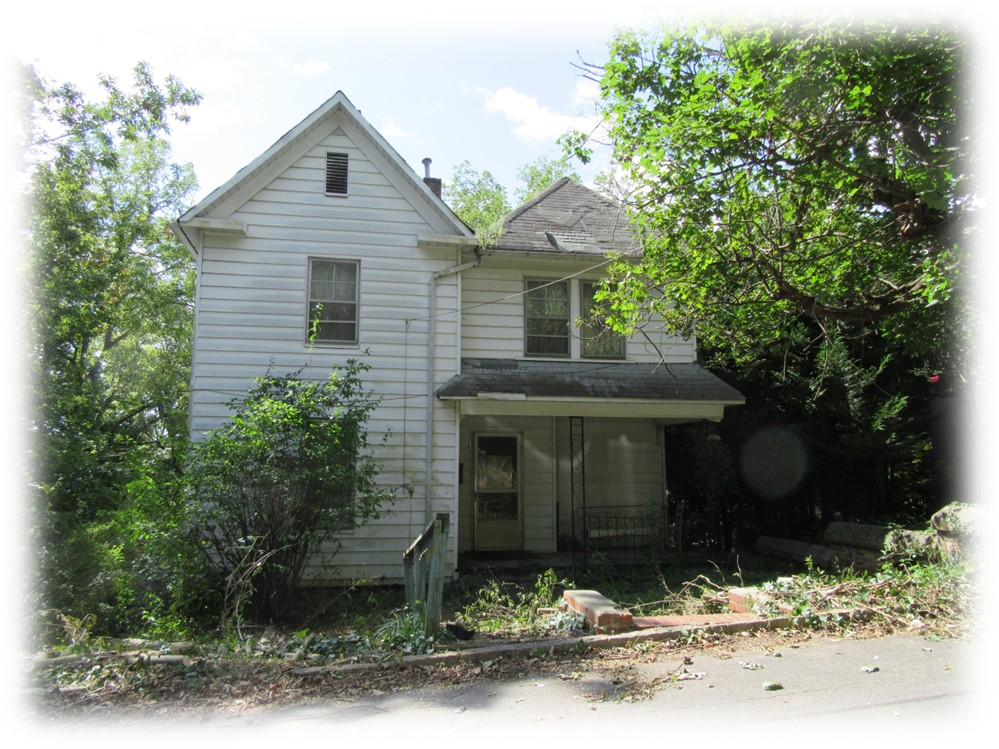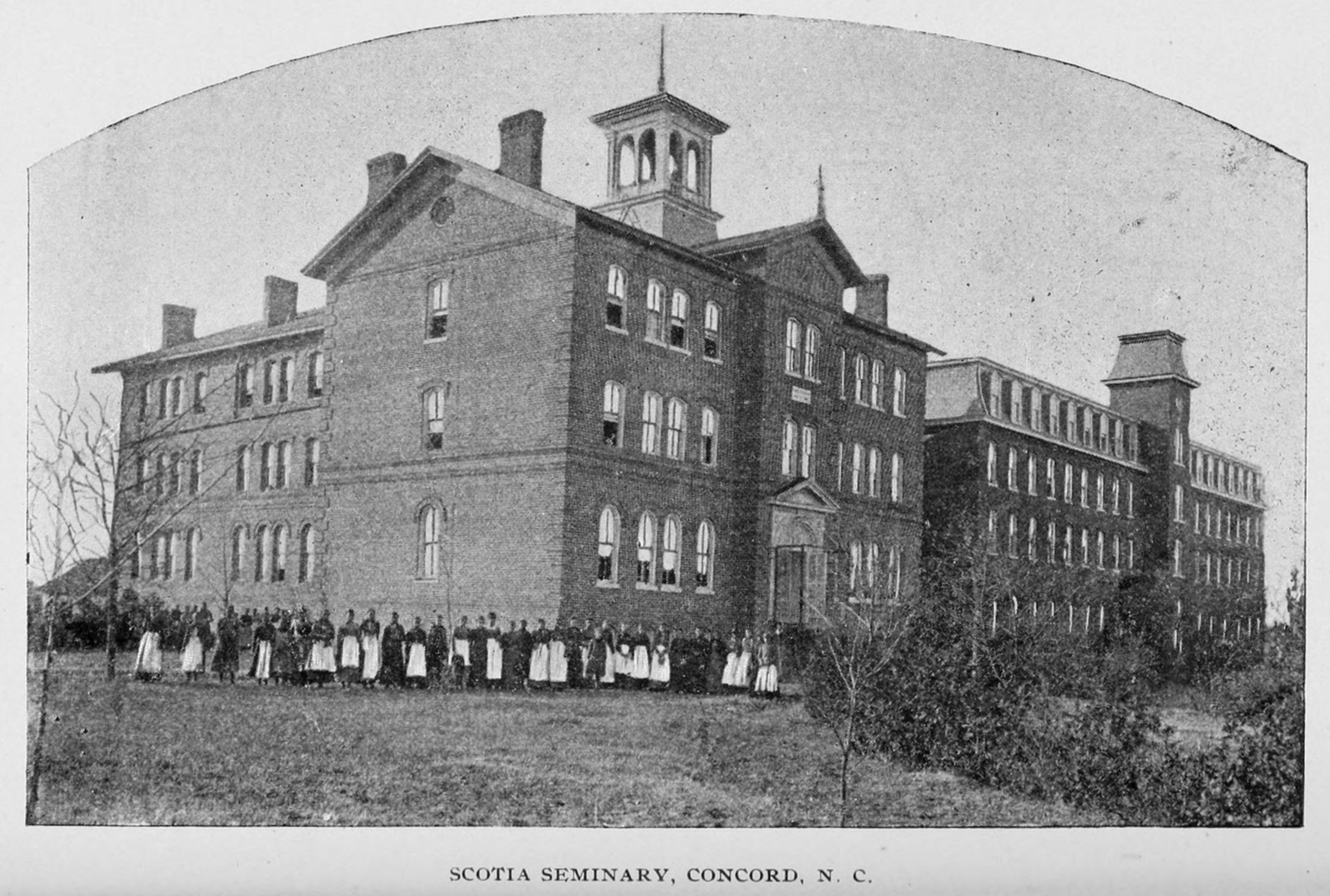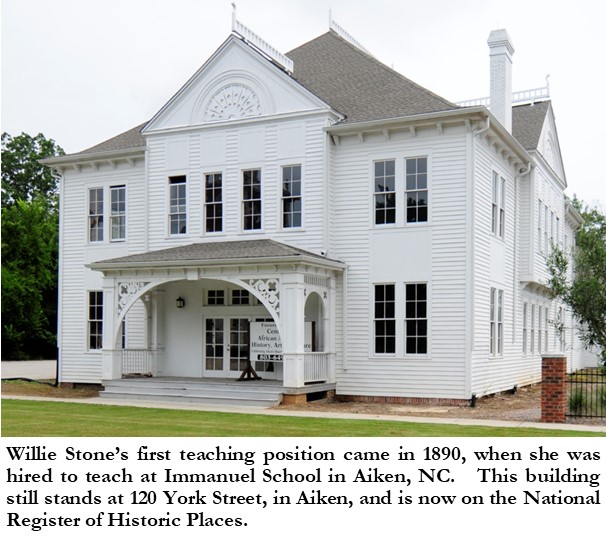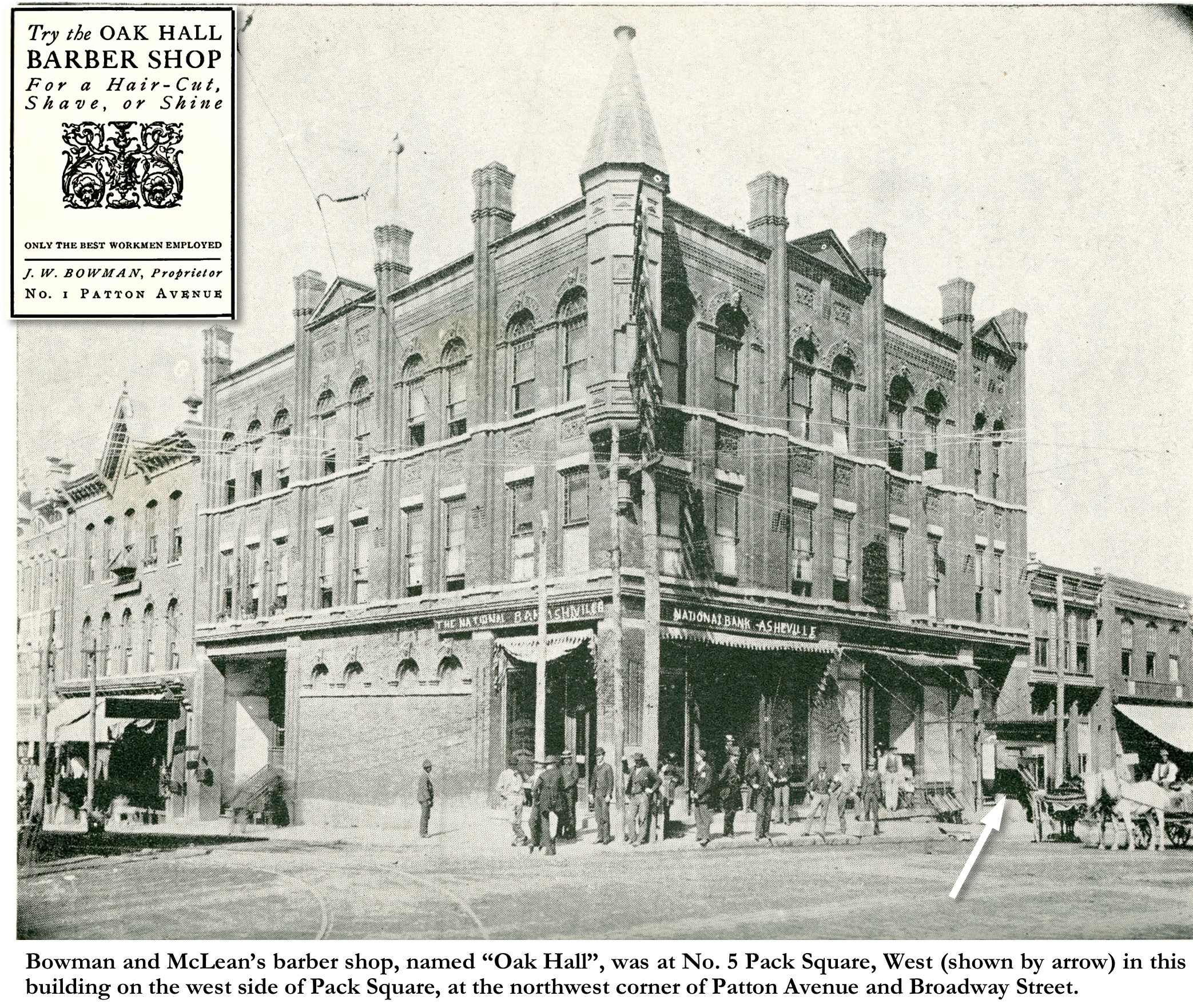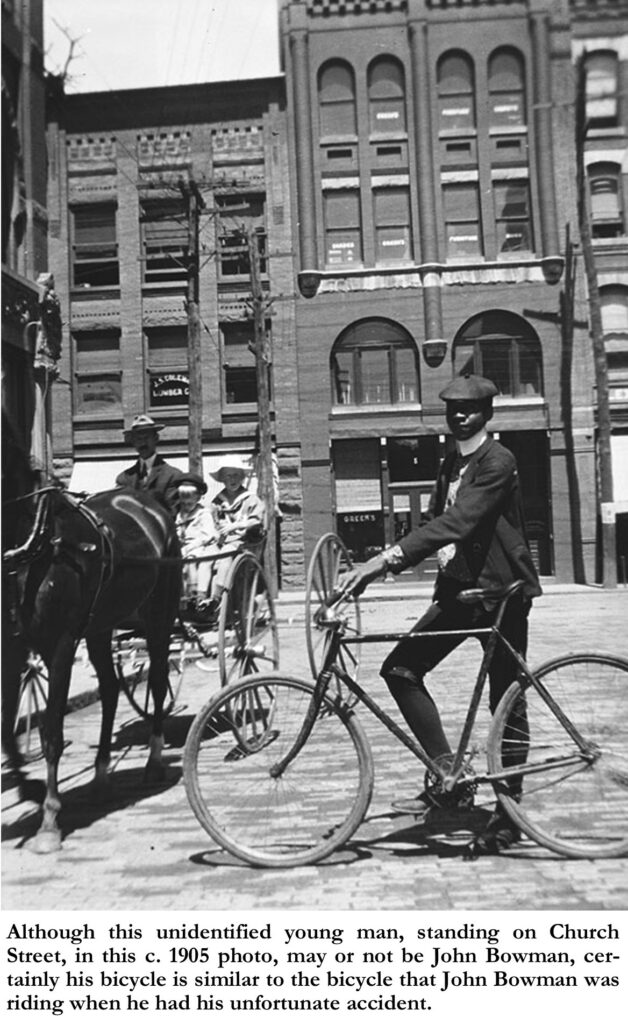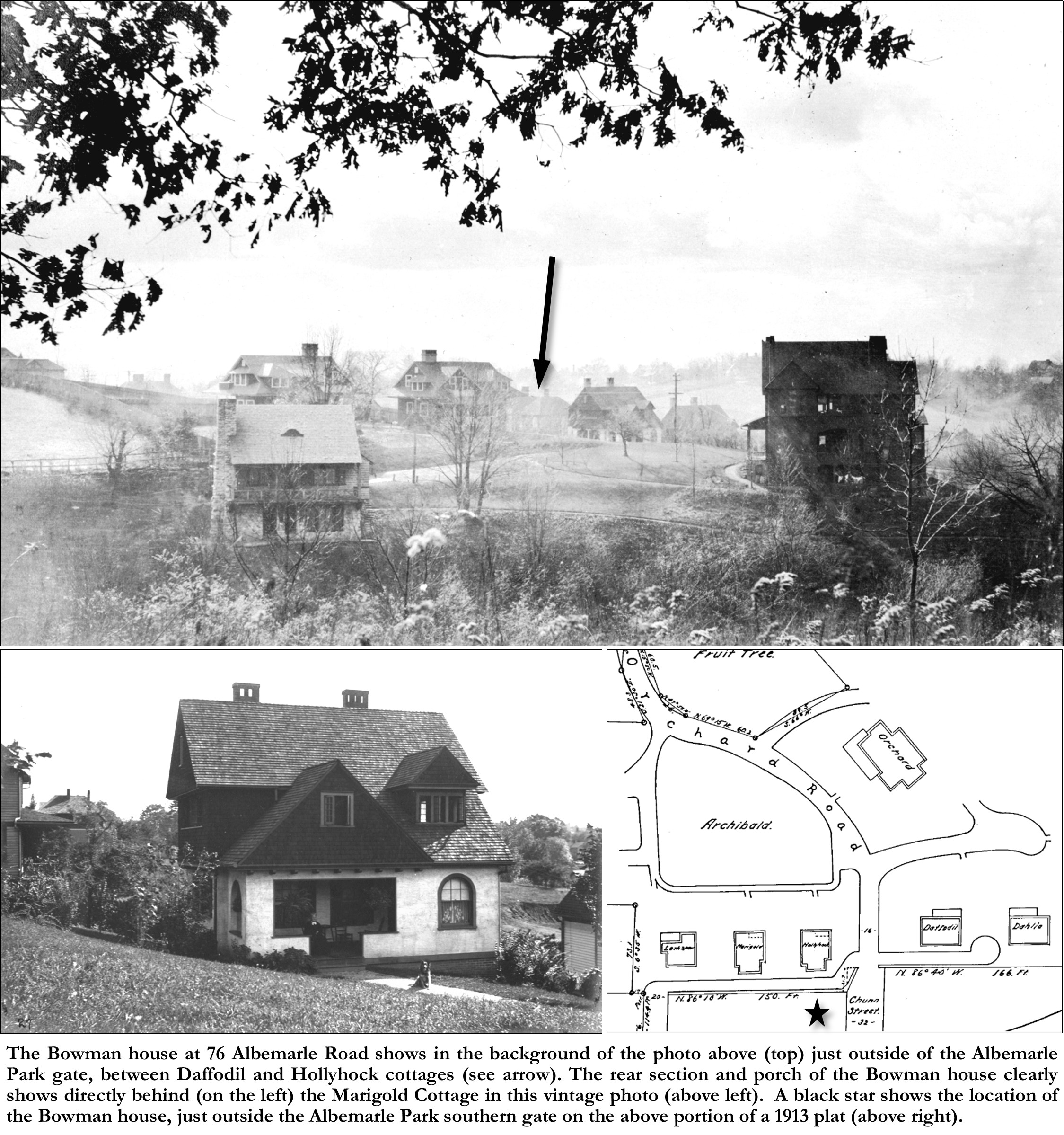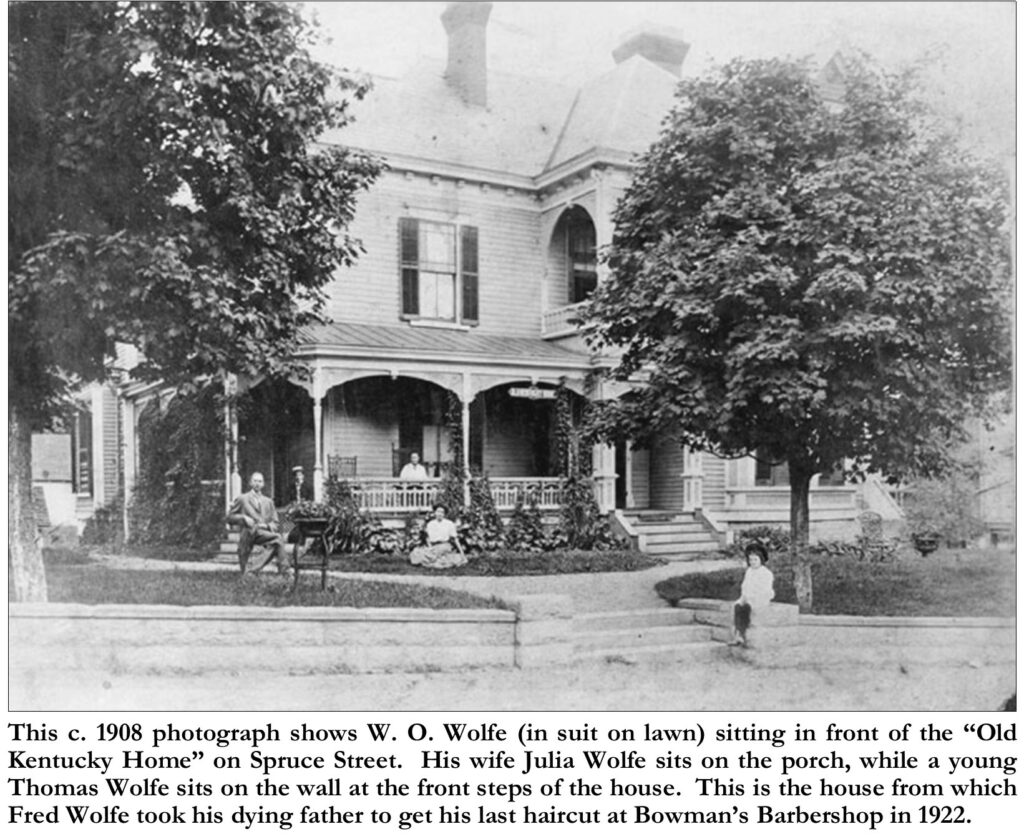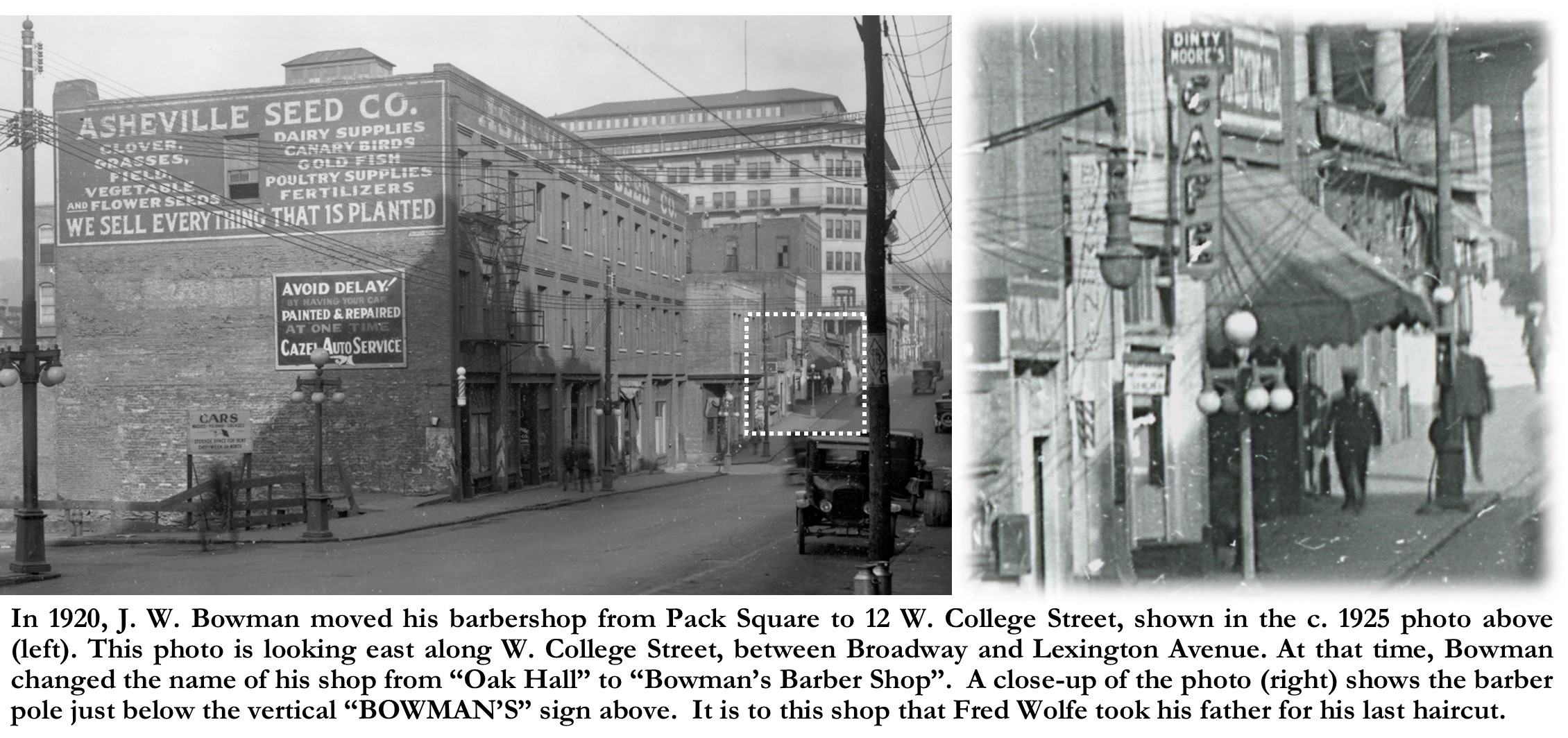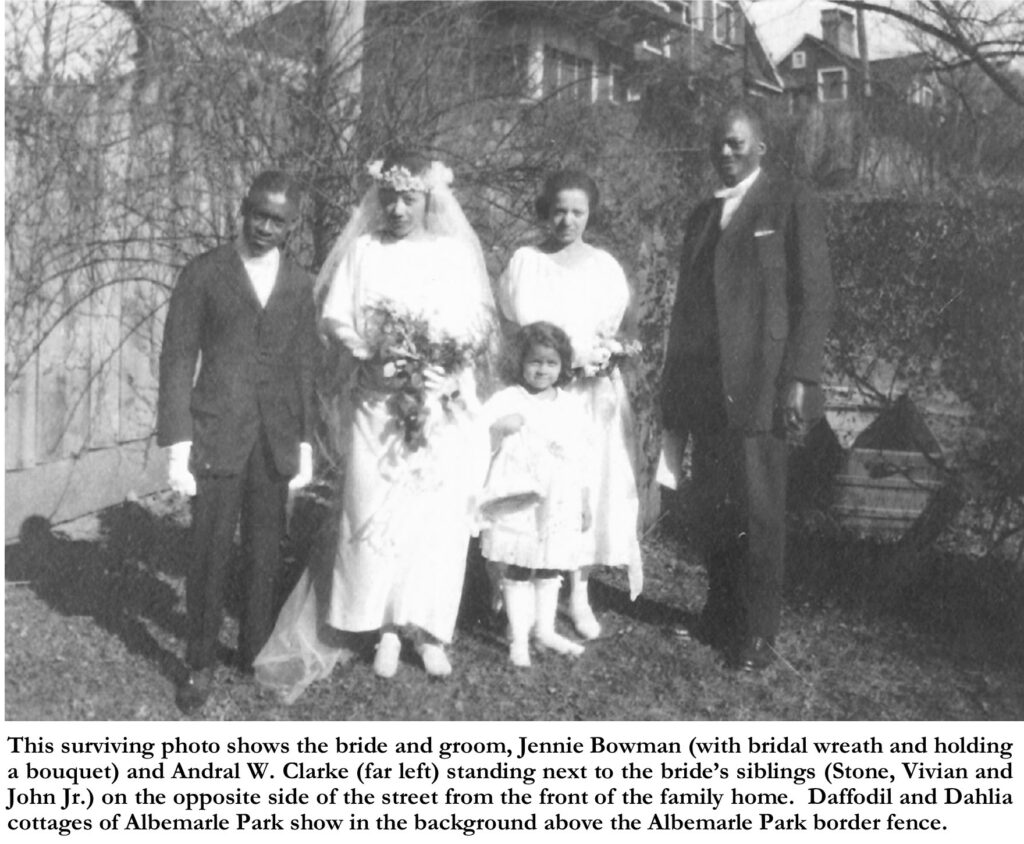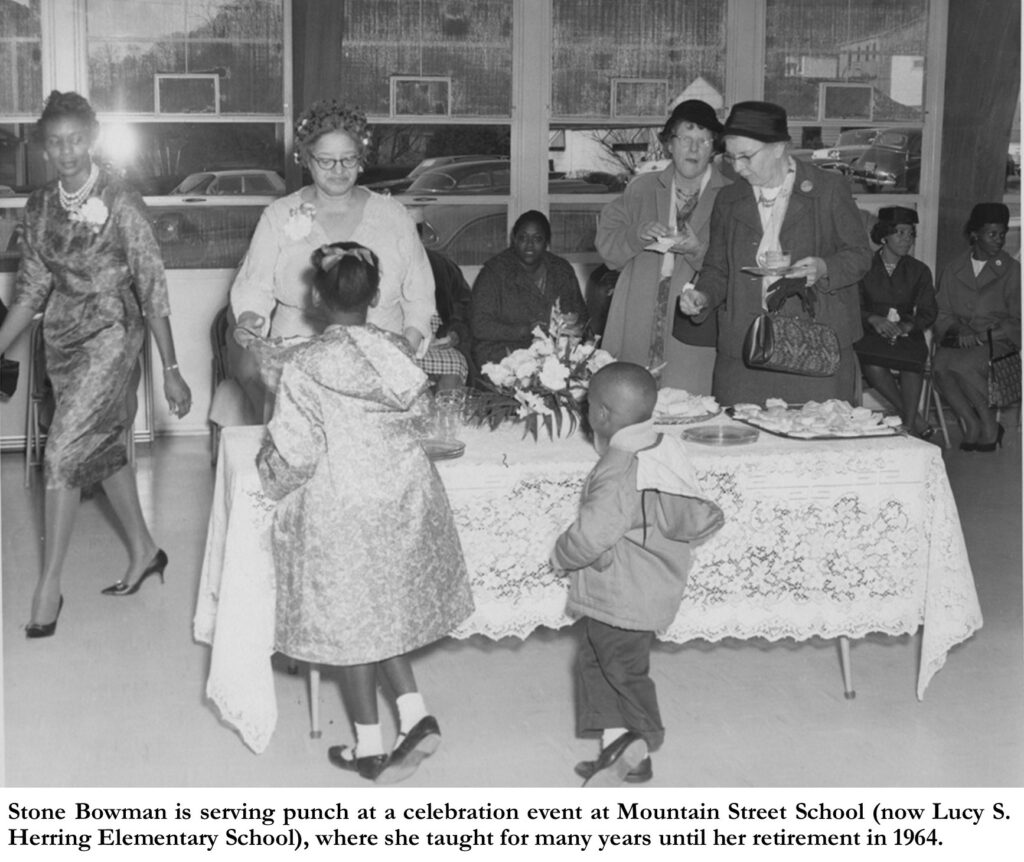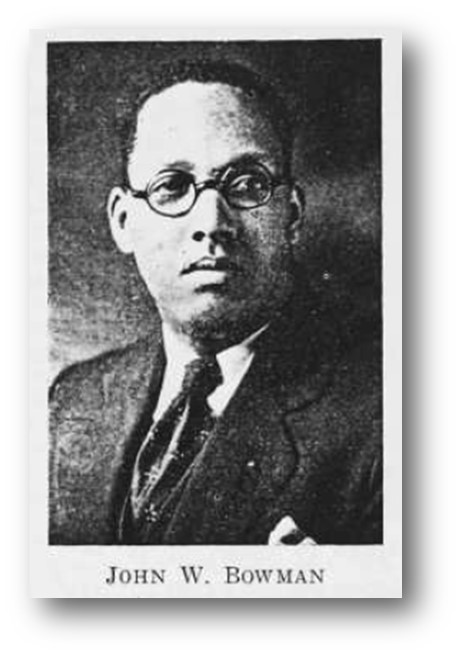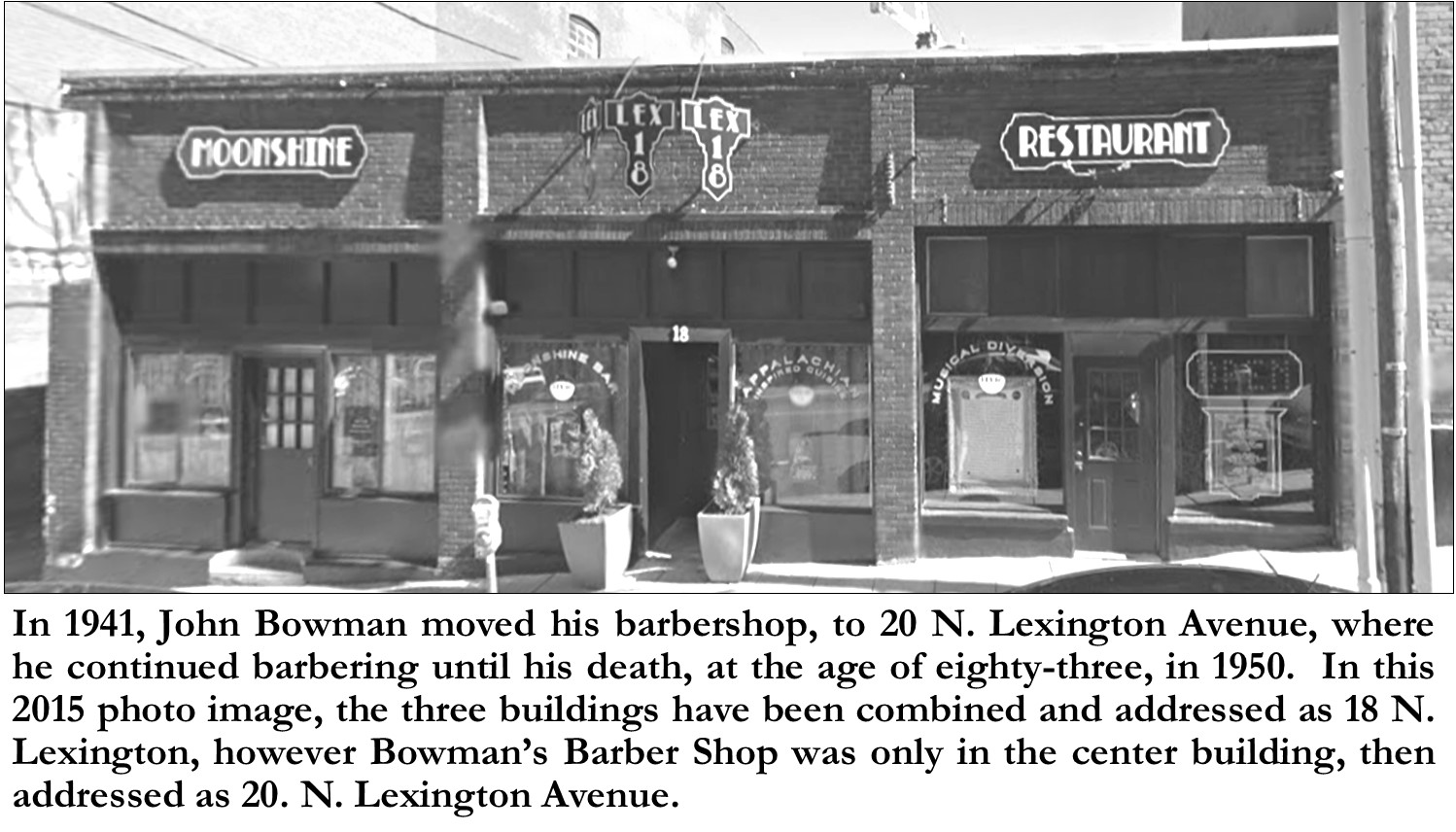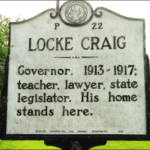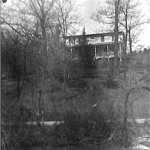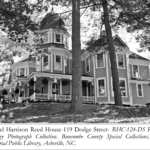By Dale Wayne Slusser- September 10, 2024
In the heart of Asheville’s historic Charlotte Street neighborhood, in the shadow of the historic Manor and Albemarle Park grounds, is a humble two-story house built by African-American John William Bowman and his wife Willie John Bowman in 1901. Although it is admirable when any house remains in the same family for decades, but in the case of the Bowman house which has remained in the family of its original owners for over 120 years, it is especially admirable. Built just after the landmark legal decision of Plessy vs. Ferguson of 1896 which legalized racial segregation of public places and paved the way for sanctioned segregation of schools and neighborhoods, the Bowman house is a rare survivor of an African American homeplace. The Bowman house is also a rare survivor, as many African-American homes of the late-nineteenth and early twentieth-century did not survive the massive 1950’s-1960’s housing projects which resulted in the destruction of many of the homes in historically Black neighborhoods, all in the guise of “urban renewal”.
I have used the word “homeplace” as it is a very descriptive legal word that is often used in deeds and probate records in the South, and in fact was used in the probate court records following the death of J. W. Bowman[1]. The word “homeplace” is very inclusive in that legally it denotes a family residence-that is-house, land and location all in one word. But for the family itself, homeplace, means the home (house and land) where a family was raised, and memories were made. And I’m sure the Bowman house was a place of many fond memories.
John William Bowman was born in 1866, to freedman John Edd Bowman and his wife Jane Irby Bowman, in Charleston, South Carolina.[2] There is little documentation of Bowman’s early life. He appears to have been the 4-year-old son, named William, of 25-year-old, Jane Bowman in the 1870 U.S. Federal Census. Jane Bowman, is listed as a cook living with her son William, in Charleston, SC, in a household with two other families, the Bradefords and the Garreds.[3] In 1875, 30 year-old Jane Bowman, listed as a “house servant” on Queen Street, died of “phthisis pulmonalis”[4], commonly known as consumption (tuberculosis). I believe this to be John William Bowman’s mother, Jane Irby Bowman. Her death notice says that she had been living in Charleston for ten years, since 1865, the year before John William Bowman’s birth. It appears that after Jane’s death, her nine-year old son, John William was sent to live with his uncle James Irby in Laurens, SC. In the 1880 US Federal Census, 13-year-old “Willie Bowman” is listed as “nephew” living with James Irby and his family.[5] Interestingly, Bowman’s uncle, James Irby’s occupation was listed as “barber”![6]
In 1891, John W. Bowman married Miss Willie John Stone, of Newberry, SC. Willie J. Stone was born in 1868 to Willie Dovan and Elizabeth Stone in Newberry, SC.[7] Willie J. Stone had not only graduated from grade school, but in 1882, at the age of fourteen she was enrolled at Scotia Seminary in Concord, NC. Scotia Seminary was founded in January 1867 by Reverend Luke Dorland, who was commissioned by the Presbyterian Church, U.S.A. to establish in the South, an institution for the training of African-American girls/women. Concord, North Carolina, was selected as the location of the school due to its demographics. The original purpose of the college was to prepare women to go into the fields of education and social work.[8] Willie J. Stone graduated from Scotia Seminary in 1889 with a teaching degree. Her first position as a teacher came in 1890, when she was hired to teach at Immanuel School in Aiken, NC.[9] Immanuel School was started in 1881 by Rev. W. R. Coles, a Presbyterian minister, as an outreach of the Board of Missions for Freedman of the Presbyterian Church, U.S.A. No doubt, “Miss Willie J. Stone” taught in the schools “new” building that had just been completed the year before (1889). This building still stands at 120 York Street, in Aiken, and is now on the National Register of Historic Places.
John and Willie Bowman had their first child, daughter Jennie J. in 1892, in Laurens, SC. Their second child, son John William, Jr. was born in Laurens in 1895. I assume that John William Bowman was barbering at the time, either with his uncle, James Irby, or on his own. Willie Bowman was also teaching in Laurens, though it is unclear whether it was before and/or after her 1891 marriage.[10] At that time (1891-1895), Laurens had only three “colored” schools, where Willie Bowman could have taught. Mt. Pisgah School or Calvary School were both operated by the Board of Missions for Freedman of the Presbyterian Church, U.S.A.[11], which was the same organization through which Willie had served under while teaching in Aiken. The other possibility was the “Colored Graded School”, which was part of the public school system in Laurens.[12]
In 1895, John W. Bowman decided to move his small but growing family to Asheville. He and the family first moved into a rental house at 79 Montford Avenue (now 83 Montford Avenue). I assume that Bowman had been barbering for a few years, while still in Laurens, as in May of 1895, shortly after moving to Asheville, he and a fellow barber, W. H. McLean (aka: McLain) formed a partnership called “Bowman & McLean”. They purchased (and mortgaged) a load of Barber equipment and furnishings from “Theo. A. Kochs”, a major barber-supply manufacturer. For “$299.50”, they purchased: “Four (4) Number #81 Progress Barber Chairs, Antique Oak, crimson plush…Number #168 mirror case for four chairs, One (1) Number #92 Washstand antique oak,” all to be installed in “the building known as #1 Patton Avenue”.[13]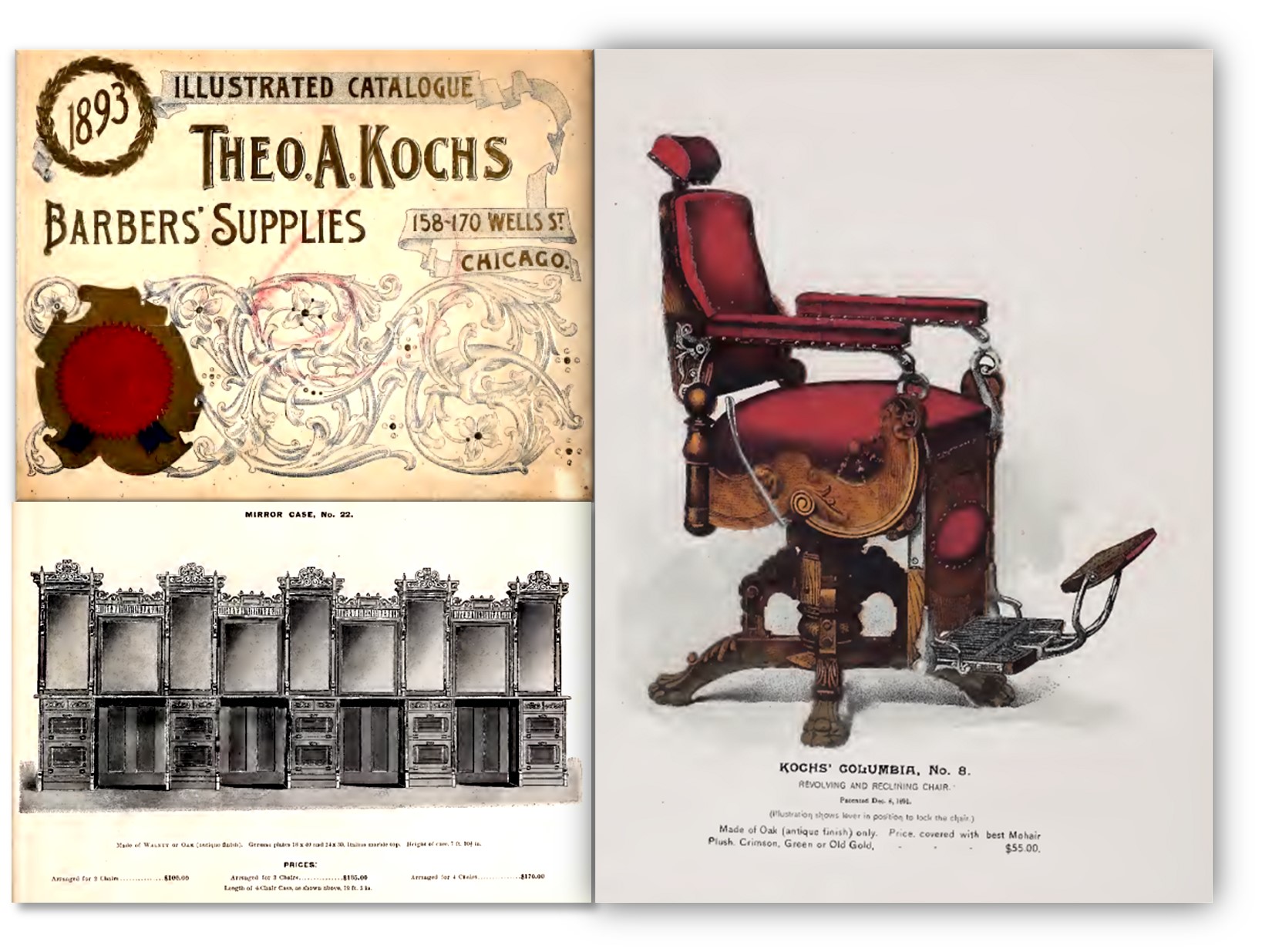
Bowman and McLean’s new barber shop, named “Oak Hall”, was in a building on the west side of Pack Square, at the northwest corner of Patton Avenue and Broadway Street. This building was replaced in 1965 by the Northwestern Bank, later called the BB &T building, and since its remodeling in 2019, it is known as “The Arras”, a hotel and condominium complex. Bowman & McLean were able to fully pay off the deed of trust for the equipment and furnishings in just three years (1898).[14] Oak Hall Barber Shop, which catered to the “white trade” advertised that they offered: “Haircutting, Shaving, Singeing and Shampooing”, along with, “Good Razors, Clean Towels, and Polite Attention”.[15] The shop needed those four chairs, as besides Bowman and McLean, they hired several other employee barbers. In both the 1896 and 1899 Asheville City Directories, three additional barbers were listed as working at Oak Hall Barber Shop.[16] Of course that was five barbers for four chairs-they must have purchased more chairs, or I suspect they shared chairs, perhaps working shifts?
By 1899, Bowman had made enough money to think of building a house for his family, and to that end, in November of 1899, he purchased “Lot #16” in the James Buttrick subdivision on Chunn Street (now Albemarle Place).[17] The small subdivision, which was set up by British-born architect and building supplies manufacturer, James Buttrick in 1887, consisted of 28 lots bordered by Charlotte Street on the west, and Chunn Street on the east, between Blair Street on the south and Albemarle Park on the north. Buttrick partnered with real estate agent Natt B. Atkinson to market the lots in what was named the “Atkinson & Buttrick” plat.[18] The lots in the small subdivision did not sell quickly, and it appears that the first lots that were sold were bought mainly by investors. So, by 1899 (twelve years later), when Bowman bought his first lot, there were only a few lots that had been built on leaving many vacant lots. In fact, over the following few years (1899-1905), Bowman was able to purchase the three adjacent vacant lots (#17, 18, & 19)[19] giving him a property of three-quarters of an acre, which was a large property for an urban house.
In March of 1900, just a few months after purchasing that first lot, Bowman was involved in a serious bicycle accident:
“Will Bowman, colored, proprietor of the Oak Hall barber shop on Patton avenue, met with a serious accident while riding on his bicycle down South Main street yesterday. Bowman was riding at a rapid rate and in an effort to make a turn ran into a delivery wagon near the express office. The rider fell forward from his wheel, striking his face against an iron axle between the hub and frame of the wagon, inflicting a severe wound. The inner part of his mouth was badly lacerated and several teeth damaged. The wounds bled profusely, leaving a stream of blood from the place of the accident to Dr. Walter Hilliard’s office, where he was taken.”[20]
Another article clarified the extent of Bowman’s injuries: “Bowman’s lower lip was cut and two teeth were knocked out”.[21]
Perhaps Bowman’s accident slowed down his house building schedule, or perhaps he needed more time to save up the funds to build his house, nonetheless, construction of his house did not start until 1901. Although, in 1900, he did increase his property size by purchasing the adjacent “Lot #17”, perhaps in anticipation of beginning construction soon thereafter.
The Bowman house was built as two-stories, however due to the steepness of the lot, a full walkout, partially finished basement at the rear makes the rear of the house three-stories high. Originally built in a truncated -L configuration with the left-wing projecting toward the front with a flared-gable, a later addition above the front porch now makes the house appear as a rectangle. Underneath the existing 1963 aluminum siding[22] is the houses’ original wood dutch-lap siding. The house was first addressed as 124 Chunn Street, which first appears in the 1902 Asheville City Directory. Therefore, we can assume that construction of the house was completed by 1901, as most likely the information for the 1902 Directory was gathered in late 1901, for publishing in 1902. I have found no record indicating who the architect and/or builder was who built the house.
I would be amiss to tell the story of the Bowman house, without at least a brief mention of its next-door neighbor “Albemarle Park”. William Greene Raoul, a railroad executive from Georgia purchased the 34-acre Deaver farm on North Charlotte Street in 1886 as a summer retreat for his family. A decade later, in coordination with his son Thomas Wadley Raoul, and with the professional aid of architect, Gilbert L. Bradford and landscape architect Samuel L. Parsons, William Raoul, beginning in 1897, transformed the Deaver farm into a unique picturesque “cottage” development named “Albemarle Park”.
Landscape architect, Samuel Parsons developed a master plan for the new residential park. Parsons’s plan started with a stone entrance Lodge/Gatehouse at Charlotte Street (lowest part of the site) from which a main thoroughfare, later named Cherokee Road, rose first to a three-acre leveled plateau which was used as the site of the proposed Boarding house. Parsons described this area as a “little open meadow…where only is to be noticed any considerable stretch of turf for greensward”.[23] It was on the northwest section, closest to the Lodge/Gatehouse that the Boarding house, named “The Manor” (as suggested by architect Gilbert Bradford) was sited. The first two cottages, Columbus and Clover, were built flanking the drive into The Manor. Later an additional half-dozen cottages were built on the plateau.
Parsons designed the main thoroughfare (Cherokee Road) to continue to wind up the hillside and connect to a network of circuitous roads, lined by divided lots, which followed the contours of the site. The whole resulted in a series of terraced (though cleverly disguised as such) homesites. Part of the way up Cherokee Road, on the southwest side of the property, Orchard Road was designed to leave Cherokee Road and end at another gate into the park on the south end. Orchard Road then connected to Chunn Street (now Albemarle Road) at the gate.
The Bowman house was built just outside of the southern Albemarle Park gate, and in fact the original stone gateposts still survive- the western post being almost in the corner of the Bowman’s front yard. Orchard Cottage in Albemarle Park, near the Orchard Road gate was finished in 1899, the year that Bowman purchased his first lot. Four cottages, Daffodil, Dahlia, Hollyhock, and Marigold were later built (after the Bowman house was completed) along the inside of the fence at the Orchard Road gate, thereby becoming the Bowmans’ adjacent “neighbors”.
Upon completion of their new four-bedroom house in 1901, 35 yr-old John Bowman and his wife Willie moved in with their growing family of three children, Jennie (age 9), John Jr. (age 6) and infant daughter, Stone. Daughter Vivian was born three years later (1904), and an adopted daughter Otyvee, joined the family in 1912.
One of the first pieces of furniture that was probably moved to the new house, or purchased shortly thereafter, was a piano, as Willie Stone Bowman used her teacher training obtained from Scotia College, to supplement the family income by giving piano lessons in her home. No doubt she also had obtained her music training at Scotia College, under the tutelage of Miss Ida S. Cathcart, who was head of Scotia’s “Vocal and Instrumental Music” department during the mid-late 1880’s, when Willie was enrolled at Scotia College. I suspect that Willie’s passion for music was not merely as a means of income, for not only did she teach her children to sing, play the piano, the organ and the violin, but she continued giving piano lessons until the age of 98, just three years before her death![24]
John Bowman and his barbershop were well respected in the community. In her 1961 memoir, Thomas Wolfe and His Family, Mabel Wolfe Wheaton, sister of Asheville’s famed author, recalled the last time her father, W. O. Wolfe, visited Bowman’s barbershop, just a few weeks before his (Wolfe’s) death in June of 1922. Mabel’s brother Fred Wolfe had just returned home to Asheville, after graduating from Georgia Tech, and was visiting his father who was then living at the family’s boarding house, “Old Kentucky Home”:
Soon it was dinnertime and Fred wheeled him [“Papa”] into the dining room and he sat with us as we ate; I believe he ate a little. An hour later Fred announced to him that he was going to take him downtown. “I’m going to take you down to Bowman’s and you’re going to get that hair cut.” “Would you son? Would you do that?” “Sure,” said Fred, “that’s exactly what I’m going to do.”
Someone, maybe one of the boarders, helped Fred get Papa down the front steps and out to the sidewalk, and he wheeled him up Spruce Street and across Pack Square. All along the way people were stopping Papa and shaking hands with him and exclaiming how glad they were to see him, and Papa was as delighted as a child the first day out of school. Fred rolled him into Bowman’s Barber shop. Bowman was a Negro barber who had been operating in that same stand [shop] for forty or fifty years; he employed four or five Negro barbers. Papa liked Bowman and had been a customer of his for many years.”[25]
Although I believe that W. O. Wolfe did get his last hair cut in the summer of 1922 at Bowman’s Barber Shop, Mabel’s recollections have a few errors, whose corrections are pertinent to our story. In 1920, Bowman had moved his shop from Pack Square, where he had been operating for twenty-five years, not “forty or fifty”, to 12 West College Street, a block north of Pack Square. At that time, Bowman changed the name of his shop from “Oak Hall” to “Bowman’s Barber Shop”. His new shop was on the north side of W. College Street between Broadway and Lexington Avenue (the site is now a parking lot). According to the 1922 and 1923 Asheville City Directories, the other barbers who W. O. Wolfe may have seen working in Bowman’s shop may have been: William Gilmore, Stanley McDowell, James H. Reed, John W. Williams, and/or Edgar F. Young.
In 1923, the Bowman’s oldest daughter, Jennie Josephine Bowman married Jamaica-born, Andral Wellington Clarke at the house on Albemarle Road. A surviving photo shows the bride and groom, standing next to the bride’s siblings on the opposite side of the street from the front of the family home. Daffodil and Dahlia cottages of Albemarle Park show in the background above the Albemarle Park border fence. Rev. Andral Wellington Clarke and his new bride went on to serve Seventh-Day Adventists congregations in Jacksonville, FL; Springfield, MA, and Boston, MA; and Hartford, New Haven and Bridgeport in Connecticut. The couple later served in Brooklyn, NY and Chicago, IL, ending up in Portland, OR, Rev. Clarke’s last charge.[26] Jennie Bowman Clarke, prior to her marriage to Rev. Clarke had received her education first at Walden University (1912-1918), a historically black college in Nashville, TN. Then Jennie attended Fiske University, before graduating Suma Cum Laude from Clark University (Atlanta, GA) in 1919, with a degree in Classical Languages and Music. Jennie also served as a teacher in private and public schools prior to her 1922 marriage. Jennie served as organist and choir director at many of her husband’s pastorates.[27]
Stone Bowman, Jennie’s sister, was the next of the Bowman siblings to obtain a college education and launch into a professional career. Stone Bowman first attended Walden University in 1917, where at the time her sister Jennie was a senior, and her brother John William, Jr. was enrolled in the “Intermediate and Preparatory Piano and Voice Culture Classes”.[28] In 1920, Stone transferred to the Junior College at Clark University, and then matriculated through the university, graduating around 1925.[29] Her obituary says that Stone taught school in Baltimore, MD, which would have been sometime between 1925 to 1930. She was a teacher at a Seventh-Day Adventist school called, Union Academy, First Ephesus Church, in Washington, DC until April of 1930, when she suffered a ruptured appendicitis.[30] After her recovery, Stone moved back to Asheville and began her long career of teaching in the Asheville City Schools. From 1930 to 1946, Stone Bowman taught at Hill Street School, then in 1947 she taught at Mountain Street School, followed by two years at Burton Street School, before returning to teach at Mountain Street School in 1951. She remained at Mountain Street School until her retirement in 1964. Like her siblings, Stone learned to play the piano from her mother, but in addition to that she taught herself to play the violin and the musical saw!
John William Bowman, Jr. was the next of the Bowman siblings to obtain a college education in pursuit of a professional career. However, John’s course of education took longer than his siblings’, and ended tragically. John William Bowman, Jr. appears to have first started his collegiate education in 1917 at Walden University, where, as mentioned previously his two sisters, Jennie and Stone were also enrolled. John was enrolled in the “Intermediate and Preparatory Piano and Voice Culture Classes”. It appears that John W. Bowman, Jr. attended Walden University from 1917-1921, as he does not show up in the Asheville City directories during those years, and then returned to Asheville in 1922 and resumed his chauffeuring business, which he had started at his home in 1916. In the Winter Quarter of 1923, John enrolled as a candidate for a Bachelor of Science degree at Howard University in Washington, DC.[31] By 1929, John, Jr. had progressed to a fourth-year student in the Medical College at Howard University, preparing to graduate in 1930.[32] In their 1929-30 yearbook, fellow classmates called him “Little John”, and described him as “… a man respected by his fellow students for his wise counsel and his unruffled dignity”, and they further claimed that “He has the makings of an Al physician and the community that gets him”.[33] However, sadly John William Bowman, Jr. never got a chance to be a physician, as on April 22, 1930, at the age of 35, just weeks before graduation, he died at the Chi Delta Mu fraternity house at 301 T Street, N. W. in Washington, DC. A few days later his body was shipped home to Asheville, to be buried in the family plot at Riverside Cemetery. The memorial in his 1930 yearbook eulogized John William Bowman, Jr. as: “A noble flame of light, destined to burn, not long, but brightly”.[34]
The Bowman’s adopted daughter, Otyvee Irene Bowman was born in South Carolina in 1912 and joined the family at an early age. In 1935, at the age of twenty-three, Otyvee Bowman married Rev. Louis H. Bland in Louisiana, and shortly thereafter the couple’s daughter, Juanita Elizabeth “Bunny” Bland, was born. Unfortunately, the marriage did not last long, and by 1940 Otyvee had returned to the house at 76 Albemarle Road.[35] A few years after moving back to Asheville, Otyvee decided to pursue a nursing career. To that end, she enrolled at the Cleveland City Hospital School of Nursing, in Cleveland, Ohio. The Cleveland City Hospital had begun admitting African-American students into its R.N. diploma school in 1930.[36] Otyvee Bowman Bland graduated from nursing school in 1949, and returned to Asheville, where in 1950, she was hired as a nurse at the Oteen Veterans Hospital. After 25 years, Otyvee retired from the Oteen Veterans Hospital in 1975. Like her siblings, Otyvee had taken piano lessons from her mother, and during her lifetime she actively used her talent by being the pianist and choir director at St. James Methodist Episcopal Church, and by playing the piano at numerous community events.
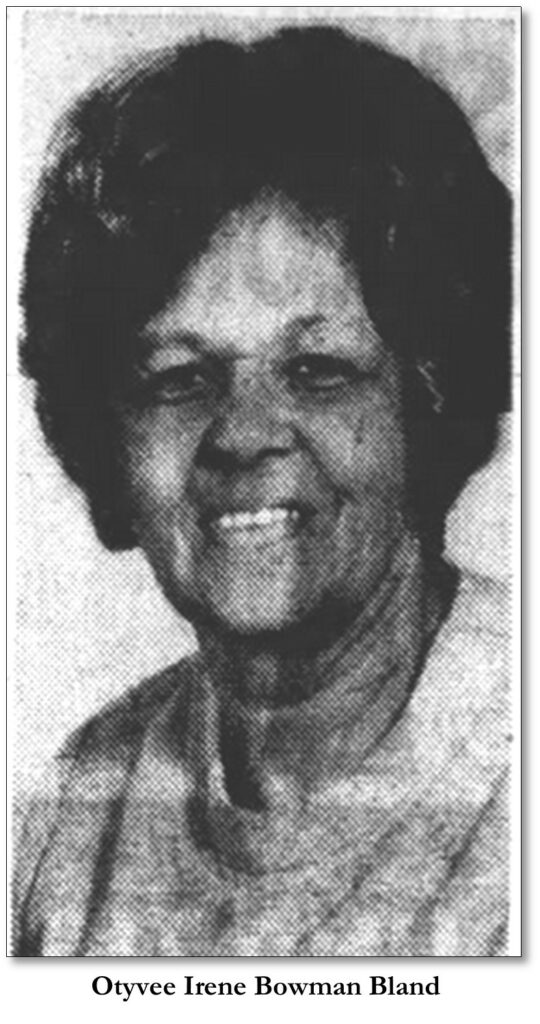 Vivian Adelaide Bowman, was born to John & Willie Bowman in 1904. Around the age of 13 or 14, Vivian became blind. Perhaps due to her blindness, she was the only Bowman sibling not to pursue a college degree. She also never married, however according to her obituary, she was a “worker” at her church, Bethel Seventh-Day Adventist Church.
Vivian Adelaide Bowman, was born to John & Willie Bowman in 1904. Around the age of 13 or 14, Vivian became blind. Perhaps due to her blindness, she was the only Bowman sibling not to pursue a college degree. She also never married, however according to her obituary, she was a “worker” at her church, Bethel Seventh-Day Adventist Church.
In 1941, John Bowman moved his barbershop, for the last time, to 20 N. Lexington Avenue, where he continued barbering until his death, at the age of eighty-three, in 1950, following a massive stroke. In his will, John Bowman left all his property to his daughter Stone Bowman, as Trustee giving his wife Willie and daughter Vivian Bowman lifetime residency in the house, with the provision that following their deaths, the property was to be divided between daughters, Stone Bowman, Jennie Clarke, and Otyvee Bland. Willie John Bowman outlived her husband by twenty years, dying in 1970 at the grand old age of 101.[37] Daughter Vivian Bowman died two years later, at the age of sixty-eight.[38]
Otyvee Bowman Bland was living next door at 1 Hillside Walk (in Albemarle Park) when she passed away in 1979. Daughter Jennie Bowman Clarke, passed away in 1986.[39] Stone Bowman was not only the last of the siblings to occupy the house, but she was also the last to pass away, in 1993.[40]
In the summer of 1983, the Bowman family had their first reunion at the house at 76 Albemarle Road. Stone Bowman, who was then 81 years old and still living in the house, was the hostess of the four-day event. Family members came from as far away as Portland, Oregon, and The Virgin Islands. One of the events was a reception held to honor the 91-year-old Jennie Bowman Clarke and her husband Rev. Andral Clarke who it was reported, “were married 61 years ago at the family home on Albemarle Road”.[41]
Although I have only told the stories of John and Willie Bowman and their immediate children, their legacy has continued and is continuing through the lives of their grandchildren, great-grandchildren, and great-great-grandchildren. This legacy was hinted at in 1983 by the newspaper reporter who besides calling them “a family of musicians”, also observed that “Beginning with Willie Bowman and continuing for four generations, no family member has less than a college degree, many have two or more master’s degrees, and some have doctorates”. The Bowman Homeplace, and the stories of John William and Willie John Bowman and their family, are both well worth telling and preserving.
Photo and Image Credits:
Scotia College c. 1896- From the 1896-1898 Biennial Report of the Superintendent of Public Instruction of North Carolina, available here: digital.ncdcr.gov/u?/p249901coll22,434176 Now Barber-Scotia College. g.co/maps/w49y5
Immanuel School, Aiken, SC- Photo by Bill Fitzpatrick, CC BY-SA 3.0 <https://creativecommons.org/licenses/by-sa/3.0>, via Wikimedia Commons
Theo. Koch’s Barber Supply Catalog Collage- Illustrated catalogue : Theo. A. Kochs barber supplies, 1893, -Internet Archive: https://archive.org/details/illustratedcatal00theo
National Bank Building, Pack Square, West– Image B080-N -National Bank of Asheville, circa 1892. This building on the corner of Pack Square NW and Patton Ave. – Buncombe County Special Collections, Pack Library, Asheville, NC.
Oak Hall Advertisement– The Sword and Rifle [serial], 1903, by Bingham Military School (Asheville, N.C.)- Internet Archive:https://archive.org/details/swordrifleserial1903bing
Young Man on bicycle c. 1905- Image OR001-8- African American with bicycle, dressed in tights, knickers, hat, high white collar and decorative shirt, on corner of Church St. and Patton Ave. – Buncombe County Special Collections, Pack Library, Asheville, NC.
View of Bowman House from Albemarle Park– Image 11454b, Volume/Box: box 39, TN: 147903- Raoul Family Papers, Stuart A. Rose Library, Emory University, Atlanta, GA.
Photo of Marigold Cottage– Image 11454y, Volume/Box: box 39, TN: 147903- Raoul Family Papers, Stuart A. Rose Library, Emory University, Atlanta, GA.
Portion of Albemarle Park Plat– 07/01/1913 ALBEMARLE PARK COMPANY- PLAT NEAR CHARLOTTE STREET, Db. 154/104. -Buncombe County Register of Deeds.
W. O. Wolfe in Front of Old Kentucky Home– Image W049-8 – Old Kentucky Home (later Wolfe Memorial) in 1908. – W.O. Wolfe sitting in a chair on the lawn, – Buncombe County Special Collections, Pack Library, Asheville, NC.
Photo and Close-up of 12 W. College Street– Image B389-8- View of College St W from Rankin Ave intersection, looking east, ca 1924. – Buncombe County Special Collections, Pack Library, Asheville, NC.
Jennie Bowman & Andral Clarke Wedding Photo– from the personal collection and courtesy of Andre W. B. Clarke, Philadelphia, PA.
Stone Bowman at Mountain Street School– Image HBH018, Heritage of Black Highlanders, Images in the Heritage of Black Highlanders Collection include photographs collected by Lucy Herring and other leaders of Asheville’s African American community in 1977. The Heritage of Black Highlanders Collection is housed in Special Collections, Ramsey Library, University of North Carolina Asheville. – https://lib.digitalnc.org/record/15623?v=uv#?xywh=-1622%2C0%2C9204%2C4765
John W. Bowman, Jr. – from Digital Howard: Howard University, “The Bison: 1930” (1930). Howard University Yearbooks.
https://dh.howard.edu/bison_yearbooks/110
Otyvee Bowman Bland– Asheville Citizen-Times, February 27, 1975, page 13.
20 N. Lexington Avenue– Image capture 2015- from 20.24 google street view
Willie Bowman, c. 1970– Image HBH113 -Heritage of Black Highlanders, Images in the Heritage of Black Highlanders Collection. The Heritage of Black Highlanders Collection is housed in Special Collections, Ramsey Library, University of North Carolina Asheville.
[1] North Carolina, U.S., Wills and Probate Records, 1665-1998 for John W Bowman, Jr. -Buncombe, Wills, Book FF-HH, 1953-1954, page 123.-ancestry.com
[2] John William Bowman’s, Social Security Application, April 1937, claims Charleston, SC as his birthplace, and Jane Irby as his mother- ancestry.com
[3] 1870 United States Federal Census for Jane Bowman, South Carolina, Charleston, Charleston Ward 2- ancestry.com https://www.ancestry.com/discoveryui-content/view/4096960:7163
[4] Death Record for “Jane Bowman” died August 18, 1875 of “phthisis pulmonalis”- ancestry.com
[5] 1880 US Federal Census, Laurens, SC- ancestry.com
[6] Ibid.
[7] Death Certificate for: Willie J. Bowman, 1970- Father’s name is listed as Willie Dovan, and mother’s name as Elizabeth Stone. In the 1880 Census, Willie is listed as the 11-year-old daughter living with her mother, “Lizzie Stone”, and an 8-year-old brother named Emmett.-ancestry.com
[8] Information from: Barber-Scotia College website- https://b-sc.edu/our-history/
[9] “Miss Willie J. Stone” was listed as one of the six teachers at Immanuel School in an 1891 report: The Twenty-Six Annual Report of the Board of Missions For Freedmen, from March 31, 1890 to April 1, 1891, …Reports of the Missionary And Benevolent Boards And Committees to the General Assembly of the Presbyterian Church In the United States of America. Philadelphia: Presbyterian Board of Publication, 1891, page 26.
[10] Willie’s obit, stated that she had “taught in Aiken and Laurens schools prior to moving to Asheville 77 years ago”.- Asheville Times, January 6, 1970, page 5.
[11] “Mt. Pisgah and Calvary” were listed in this 1891 report, as being in Laurens, under the direction of minister, G. T. Jennings: The Twenty-Six Annual Report of the Board of Missions For Freedmen, from March 31, 1890 to April 1, 1891, …Reports of the Missionary And Benevolent Boards And Committees to the General Assembly of the Presbyterian Church In the United States of America. Philadelphia: Presbyterian Board of Publication, 1891, page 26.
[12] G. T. Jennings left his position with the Presbyterian Church in 1891 to assume the post of principal at the “Colored Graded School” in Laurens. Unfortunately, in 1893, G. T. Jennings got caught in a moral failure (he got one of his students pregnant and was then convicted of “infanticide” when the baby died shortly after its birth).- The Laurens Advertiser, July 25, 1893, page 3.
[13] 05/23/1895 Bowman & McLean to Theo. A. Kochs Company of Chicago (Deed of Trust) Db. 39, page 82.-Buncombe County Register of Deeds.
[14] 05/11/1898 Theo. A. Kochs Company of Chicago to Bowman & McLean (Deed of Trust Release) Db. 106, page 220.-Buncombe County Register of Deeds.
[15] Advertisement: Maloney’s Asheville, NC City Directory-1899-1900, (Atlanta, NC: Maloney Directory Company, 1899), page 236.
[16] In 1896, besides the two proprietors (Bowman & McLean) the following three barbers are listed as working at Oak Hall: Caleb Priestly, Fred O. Reed, and George E. Reynolds. And in 1899, three different barbers are listed as barbers at Oak Hall: W. H. Butler, Amos Griel, and John L. Sulivan.
[17] 11/09/1899 (rec’d- 11/27/1899) Lon & Roxie Mitchell to John W. Bowman LOT 16 BK 69 P 564 Db. 112, page 202. -Buncombe County Register of Deeds.
[18]02/03/1887 James Buttrick and Natt Atkinson AGREEMENT Db. 57, page 475.; Also: 07/26/1887 James Buttrick and Natt Atkinson AGREEMENT Db. 59, page 558.- Buncombe County Register of Deeds. The official plat, drawn in pencil by B. F. Patton, was registered- 04/10/1890 James Buttrick – PLAT CHARLOTTE STREET Db. 69, page 564; and then a “revised and corrected” pencil sketch of the plat was re-registered-10/03/1898 James Buttrick, Esq- TO WHOM IT MAY CONCERN- PLAT CHARLOTTE & CHUNN ST Db. 106, page 538.; AND then the plat was re-drawn in ink and registered- 10/06/1898 James Buttrick – PLAT CHARLOTTE STREET Db. 8, page 38. -Buncombe County Register of Deeds.
[19] 04/26/1900 J B & Bettie Bostic to J W Bowman CHUNN ST (LOT 17), Db. 115, page 38; 04/20/1905 Haywood Parker, John Cheesborough, Jr. to J W Bowman CHUNN ST LOTS 18-19) Db.137, page 412. – Buncombe County Register of Deeds.
[20] “BICYCLE ACCIDENT- Rider Runs Into a Delivery on South Main Street”, Asheville Daily Gazette, March 24, 1900, page 5.
[21] Asheville Citizen-Times, March 4, 1900, page 4,
[22] Asheville Citizen-Times, August 22, 1963, page 24. –“Stone E. Bowman, re-side residence, 76 Albemarle Rd., $2,400.”
[23] S. Parsons, Jr. How to Plant the Home Grounds. (New York: Doubleday & McClure Co., 1899), p. 178.
[24] “Bowman Family Gathering”, Asheville Citizen-Times, July 13, 1983, page 7.
[25] Thomas Wolfe and His Family, by Mabel Wolfe Wheaton, with LeGette Blythe. (New York, NY: Doubleday & Company, Inc., 1961) page 201.
[26] “A Service of Celebration For the Life of Rev. A. Wellington Clarke”, September 6, 1995, Bethel Seventh-Day Adventist Church, 457 Grand Avenue, Brooklyn, NY. -https://www.blacksdahistory.org/biographies
[27] “Obituary of Jennie B. Clarke”, North American Regional Voice: Official Organ of the North American Regional Conferences of the Seventh-Day Adventists, Vol. 8 No. 6., August 1986- Chicago, IL, page 18.- Adventist Archives https://documents.adventistarchives.org
[28] Catalogue of Walden University: fifty-second year: 1917-1918. Pages 29, 30, & 33. – accessed from the University of Tennessee Library, Knoxville, TN – https://digital.lib.utk.edu/collections/islandora/object/collections%3Awalden
[29] The Clark University Bulletin: Catalogue Number 1921-1923 vol. IV no.1; The Clark University Bulletin: Catalogue Number 1922-1924 vol: V no. I; – https://radar.auctr.edu/islandora/object/auc.004.cc.catalogs%3A9999
[30] Columbia Union Visitor, Vol. 35 – No. 13, April 3, 1930, page 4.- General Conference of Seventh-day Adventist ; https://documents.adventistarchives.org/Periodicals
[31] University, Howard, “1924 – Howard University Commencement Program” (1924). Howard University Commencement Programs. 75. – https://dh.howard.edu/hugradpro/75
[32] Howard University, “The Bison: 1930” (1930). Howard University Yearbooks. 110. https://dh.howard.edu/bison_yearbooks/110
[33] Ibid
[34] Ibid.
[35] The 1940 U. S. Census shows Otyvee living in Asheville, NC with her parents and siblings. On the Census her marital status is listed as “single”, no doubt she and Louis had separated by then, although their divorce was not finalized until 1943. -Census and Divorce record accessed through ancestry.com.
[36] “Nursing”, Encyclopedia of Cleveland History, Case Western Reserve University. – https://case.edu/ech/articles/n/nursing
[37] “Mrs. Bowman, 101, Dies”, Asheville Citizen-Times, January 6, 1970, page 5.
[38] “Miss Vivian Bowman”, Asheville Citizen-Times, June 23, 1972, page 3.
[39] “Jennie Clarke”, Asheville Citizen-Times, March 6, 1986, page 15.
[40] “Stone E. Bowman”, Asheville Citizen-Times, November 18, 1993, page 29.
[41] “Bowman Family Gathering”, Asheville Citizen-Times, July 1, 1983, page 7.

